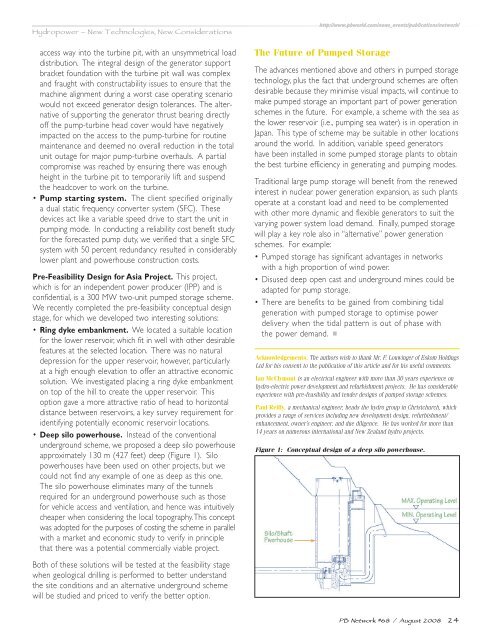Innovation in Global Power - Parsons Brinckerhoff
Innovation in Global Power - Parsons Brinckerhoff
Innovation in Global Power - Parsons Brinckerhoff
Create successful ePaper yourself
Turn your PDF publications into a flip-book with our unique Google optimized e-Paper software.
Hydropower – New Technologies, New Considerations<br />
access way <strong>in</strong>to the turb<strong>in</strong>e pit, with an unsymmetrical load<br />
distribution. The <strong>in</strong>tegral design of the generator support<br />
bracket foundation with the turb<strong>in</strong>e pit wall was complex<br />
and fraught with constructability issues to ensure that the<br />
mach<strong>in</strong>e alignment dur<strong>in</strong>g a worst case operat<strong>in</strong>g scenario<br />
would not exceed generator design tolerances. The alternative<br />
of support<strong>in</strong>g the generator thrust bear<strong>in</strong>g directly<br />
off the pump-turb<strong>in</strong>e head cover would have negatively<br />
impacted on the access to the pump-turb<strong>in</strong>e for rout<strong>in</strong>e<br />
ma<strong>in</strong>tenance and deemed no overall reduction <strong>in</strong> the total<br />
unit outage for major pump-turb<strong>in</strong>e overhauls. A partial<br />
compromise was reached by ensur<strong>in</strong>g there was enough<br />
height <strong>in</strong> the turb<strong>in</strong>e pit to temporarily lift and suspend<br />
the headcover to work on the turb<strong>in</strong>e.<br />
• Pump start<strong>in</strong>g system. The client specified orig<strong>in</strong>ally<br />
a dual static frequency converter system (SFC). These<br />
devices act like a variable speed drive to start the unit <strong>in</strong><br />
pump<strong>in</strong>g mode. In conduct<strong>in</strong>g a reliability cost benefit study<br />
for the forecasted pump duty, we verified that a s<strong>in</strong>gle SFC<br />
system with 50 percent redundancy resulted <strong>in</strong> considerably<br />
lower plant and powerhouse construction costs.<br />
Pre-Feasibility Design for Asia Project. This project,<br />
which is for an <strong>in</strong>dependent power producer (IPP) and is<br />
confidential, is a 300 MW two-unit pumped storage scheme.<br />
We recently completed the pre-feasibility conceptual design<br />
stage, for which we developed two <strong>in</strong>terest<strong>in</strong>g solutions:<br />
• R<strong>in</strong>g dyke embankment. We located a suitable location<br />
for the lower reservoir, which fit <strong>in</strong> well with other desirable<br />
features at the selected location. There was no natural<br />
depression for the upper reservoir, however, particularly<br />
at a high enough elevation to offer an attractive economic<br />
solution. We <strong>in</strong>vestigated plac<strong>in</strong>g a r<strong>in</strong>g dyke embankment<br />
on top of the hill to create the upper reservoir. This<br />
option gave a more attractive ratio of head to horizontal<br />
distance between reservoirs, a key survey requirement for<br />
identify<strong>in</strong>g potentially economic reservoir locations.<br />
• Deep silo powerhouse. Instead of the conventional<br />
underground scheme, we proposed a deep silo powerhouse<br />
approximately 130 m (427 feet) deep (Figure 1). Silo<br />
powerhouses have been used on other projects, but we<br />
could not f<strong>in</strong>d any example of one as deep as this one.<br />
The silo powerhouse elim<strong>in</strong>ates many of the tunnels<br />
required for an underground powerhouse such as those<br />
for vehicle access and ventilation, and hence was <strong>in</strong>tuitively<br />
cheaper when consider<strong>in</strong>g the local topography.This concept<br />
was adopted for the purposes of cost<strong>in</strong>g the scheme <strong>in</strong> parallel<br />
with a market and economic study to verify <strong>in</strong> pr<strong>in</strong>ciple<br />
that there was a potential commercially viable project.<br />
Both of these solutions will be tested at the feasibility stage<br />
when geological drill<strong>in</strong>g is performed to better understand<br />
the site conditions and an alternative underground scheme<br />
will be studied and priced to verify the better option.<br />
http://www.pbworld.com/news_events/publications/network/<br />
The Future of Pumped Storage<br />
The advances mentioned above and others <strong>in</strong> pumped storage<br />
technology, plus the fact that underground schemes are often<br />
desirable because they m<strong>in</strong>imise visual impacts, will cont<strong>in</strong>ue to<br />
make pumped storage an important part of power generation<br />
schemes <strong>in</strong> the future. For example, a scheme with the sea as<br />
the lower reservoir (i.e., pump<strong>in</strong>g sea water) is <strong>in</strong> operation <strong>in</strong><br />
Japan. This type of scheme may be suitable <strong>in</strong> other locations<br />
around the world. In addition, variable speed generators<br />
have been <strong>in</strong>stalled <strong>in</strong> some pumped storage plants to obta<strong>in</strong><br />
the best turb<strong>in</strong>e efficiency <strong>in</strong> generat<strong>in</strong>g and pump<strong>in</strong>g modes.<br />
Traditional large pump storage will benefit from the renewed<br />
<strong>in</strong>terest <strong>in</strong> nuclear power generation expansion, as such plants<br />
operate at a constant load and need to be complemented<br />
with other more dynamic and flexible generators to suit the<br />
vary<strong>in</strong>g power system load demand. F<strong>in</strong>ally, pumped storage<br />
will play a key role also <strong>in</strong> “alternative” power generation<br />
schemes. For example:<br />
• Pumped storage has significant advantages <strong>in</strong> networks<br />
with a high proportion of w<strong>in</strong>d power.<br />
• Disused deep open cast and underground m<strong>in</strong>es could be<br />
adapted for pump storage.<br />
• There are benefits to be ga<strong>in</strong>ed from comb<strong>in</strong><strong>in</strong>g tidal<br />
generation with pumped storage to optimise power<br />
delivery when the tidal pattern is out of phase with<br />
the power demand.<br />
<br />
Acknowledgements. The authors wish to thank Mr. F. Louw<strong>in</strong>ger of Eskom Hold<strong>in</strong>gs<br />
Ltd for his consent to the publication of this article and for his useful comments.<br />
Ian McClymont is an electrical eng<strong>in</strong>eer with more than 30 years experience on<br />
hydro-electric power development and refurbishment projects. He has considerable<br />
experience with pre-feasibility and tender designs of pumped storage schemes.<br />
Paul Reilly, a mechanical eng<strong>in</strong>eer, heads the hydro group <strong>in</strong> Christchurch, which<br />
provides a range of services <strong>in</strong>clud<strong>in</strong>g new development design, refurbishment/<br />
enhancement, owner’s eng<strong>in</strong>eer, and due diligence. He has worked for more than<br />
14 years on numerous <strong>in</strong>ternational and New Zealand hydro projects.<br />
Figure 1: Conceptual design of a deep silo powerhouse.<br />
PB Network #68 / August 2008 24

















